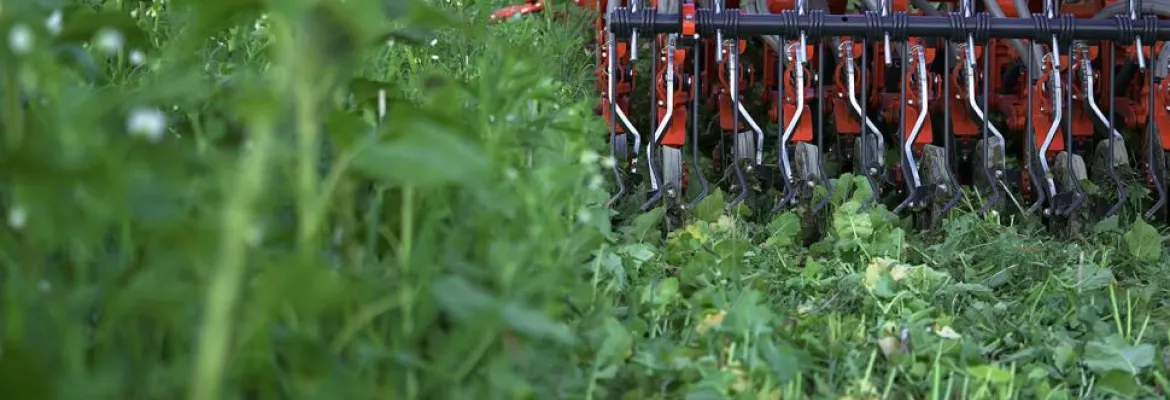
Le déchaumage est une opération culturale importante pour les agriculteurs, qui permet d'éliminer les chaumes, la paille et autres résidus laissés après la récolte pour favoriser la matière organique du sol.
Pourquoi déchaumer ? Les nombreux atouts du déchaumage
Compared to conventional soil-preparation techniques involving ploughing and minimum cultivation methods, direct drilling consists of sowing crops without any prior tillage, turning, decompaction, or seedbed preparation. The soil is only worked along the seeding line. With this method, the weather and biological activity in the soil, contribute to modifying the soil's structure. Direct drilling can be carried out in crop residues, a cover crop, or an existing crop. It is the ultimate method in minimum cultivation. Alongside rotation and plant cover, it is the third pillar of conservation agriculture.
Many advantages for the soil and savings for the farmer
Direct drilling is a response to soil erosion and soil de-structuring. It improves soil fertility and biological life. It provides flexibility in work organisation and saves fuel.
Improving soil structure
Direct drilling first appeared in North America in the mid-1970s to combat soil erosion in the Great Plains. This technique, combined with the development of herbicides to control weeds, has since developed and now covers more than 60 million hectares in this area. Direct drilling has also developed widely in South America (80 million hectares) and to a lesser extent in Europe (20 million hectares).

With the direct drilling technique, the biological reshaping of the soil and planting crops with deep root systems improves the physical condition of the soil and aerates it. Creating a stable soil structure helps to increase water and nutrient reserves available to the crops.
Increasing soil fertility and biological life
Direct drilling means no turning or fragmenting the soil's top layers. This allows crop residues to accumulate on the surface, forming a mulch that protects the soil from erosion. Surface residues also limit evaporation and improve the soil's water levels which is very important in dry areas. Mulch boosts biological activity in the soil, improving organic-matter and carbon content at the surface and deep down.
Plant cover, a precious ally for successful direct drilling
When working with the direct drilling method, permanent plant cover should be present on the plot. Direct drilling requires an integrated approach that goes beyond simply choosing the right seed drill. The method should be used for several years, with a rotation that keeps the soil covered. The idea is to plant a cover crop after harvest, and later, a crop in the cover crop. The seed drill should disturb the soil as little as possible, with direct drilling, not only to avoid stimulating weeds and bringing seeds to the surface, but also to protect the structure. It’s the roots that work the soil with direct drilling. Plant cover releases nitrogen as it decomposes, helping to form humus. The choice of plant cover must take local conditions into account, plot by plot, to provide the necessary support for seeding the crop.

Less inputs and simplified crop management
Direct drilling greatly reduces the number of passes necessary, saving fuel and labour. Less investment in equipment is required too, due to the direct drilling method necessitating only one pass with a seed drill that opens the furrow with its discs before placing the seed.
At KUHN, the Aurock seed drill can be equipped with a front roller to flatten plant cover and accelerate decomposition before depositing the seed nicely at the bottom of the furrow.
No impact on productivity
Direct drilling has no or little impact on productivity. A positive trend in the fertility of the soil is to be expected in the medium term. However, competition from the cover crop should be considered and managed accordingly: choice of species, cover crop management, soil enrichment by minerals.
Limits and necessary adaptations
Direct drilling cannot be implemented overnight, and it takes a few years before the benefits are felt in the soil. It is essential to take the time to make the necessary changes in terms of equipment and pest management. It can be a tricky technique to adopt in certain situations.
Adapting weed control
The plough plays a major role in weed control and seed-stock management, whereas direct drilling often requires the use of herbicides. One or more weeding operations are often necessary during the intercropping period to destroy weeds, but it is also necessary to think about rotation and plant cover, which help to limit weeds.
Watch out for slugs: Crop residues on the surface can be a haven for slugs which are harmful to the crop in the first few years.

Direct drilling may not always suit
- Direct drilling can be difficult to implement for crops that are sensitive to compaction and/or require a seedbed of fine soil such as certain spring crops.
- Direct drilling is trickier on silty soils where there is less structural activity due to weather conditions.
- Soil warming is slower in the spring which can result in having to sow later with suitable varieties.
- When water is limited, the plant cover left by the direct drilling method can penalise the crop.
- If the harvest of the previous crop was difficult, the direct drilling technique will not be able to repair the structural deterioration of the soil.
